.jpg)
An unassuming lone sheep attempts to comfort and empathize with an actress directed to sob. A choir ensemble sings in unison but they make no sound, only mouth movements suggesting a performance of sorts. Assembled trays of grass and seedlings sit and lounge on gallery floors. They are mingled and illuminated by Flavin-esque florescent tubes playfully hung yet serving as a source of photosynthesis for the green living organisms below them. A herd of goats peruse a blindingly illuminated white-walled gallery. There’s a trapezoid plinth in the middle of the gallery, a member of the herd hops on the plinth as if to proclaim and display its presence for an audience. All of the above are Linda Tegg’s inquisitive inquiries into the natural world around us or nonhuman kinds as she’s previously described. The results are just as poetic as they are absurdly humorous. At the crux of Tegg’s practice is an appeal to know and to learn. She stumbles upon curiosities that lead to her free-form scenarios, often sidestepping our embodied experiences of the natural world through the fixed representation of images. The activity of looking for Tegg involves breaking away from an aesthetic reaction or photographic (surface) knowledge to something more literal. Instead of mediated engagement, we can see, touch, and smell. We see the sheep doing what we wouldn’t typically expect it to be doing, the goat in a place it wouldn’t normally be found posing as a breathing sculpture on a plinths. We also see food reverting back into the plants they once were before being processed in industrial food systems —as she instigated in One World Rice Pilaf, a site-adaptive installation where Tegg meticulously grew grains and legumes she brought from the local supermarket.
A few years ago, Tegg’s questioning led her to think about the pre-settlement ground on which Melburnians walk and live on in her Grasslands installation. What plants and organisms thrived before colonial settlement? What does it look like? And what would it mean to somehow resuscitate a past that has been eradicated? Even if temporarily, the gesture of bringing into conversation parts of colonized land in a site where it would not be expected to still exist, goes quite a ways to challenge entrenched ways of viewing land—specifically the area upon which the State Library of Victoria is situated.
Just this year, that same gesture was extended for the Architecture Biennale of Venice in the project Repair. Along with a team working across varying disciplines including architects Louise Wright and Mauro Baracco of Baracco+Wright, Tegg germinated an assortment of seeds from the ever-endangered plant communities across Melbourne and presented them as is in the Australian Pavilion. Instead of working within in the restricted conditions of the gallery (or in this case pavilion), which is not built for plant life, Tegg says “we adapt[ed] the building to their needs, we put the plants at the centre”. It’s not only a small act of upending the pre-determined structure of an institution like the VAB but it also gives a nod to the resilience, especially, of these specific remnants of history that are otherwise disappearing.
In our conversation below, we start off discussing Tegg’s collaboration for Repair, we get into the ways in which mechanisms of representation are dissolved in their work, and discuss her early forays into photography that brought her to her current practice.
For me photographs are always constructed. I don’t subscribe to the idea that it is a true parallel. In some of my early works, I started to investigate this through photographing animals that had been trained to embody our idea of animal behaviour but for the camera. There’s always this understanding of a performance and untrustworthiness in the image. I’m really interested in what happens when things don’t play out based on the expectations we have set out for nature from what we’ve learned watching nature documentaries. I look to images to see how those notions are constructed and see if I can find a way of understanding things and seeing things differently.
Were you guys brought together?
Louise, Mauro and I didn’t know each other before we started working together. They share an architectural practice. They saw an art work I made in 2014 that was on the stairs of the State Library of Victoria. It was an attempt at recreating a pre-settlement plant community and bringing it back onto that site. Louise and Mauro saw that and thought it spoke to what they were thinking about as architects: to not consider land as a blank piece of paper but as a site that has layers of cultural history and ecologies that have been sustained for a long time prior to European settlement. It was through that work that we came together. There were also several other people included. It became a multidisciplinary team.
Were you guys after specific plants when you began?
Yes, we really focused on the Western Plain Grassland plant community. It was once prevalent in Victoria and a major reason why Melbourne was settled where it is. That community that was once thriving is down to one percent. It’s highly threated through urban expansion. We focused on that plant community because there was a confluence there with the plants I had been growing at the State Library, and how as architects Louise and Mauro had been thinking about the Western Plain Grasslands. Some of the seeds were collected from sites that are now roads. These Grasslands continue to be overlooked and continue to be destroyed.
Where do you find them if they are so endangered?
These species can be found in the niches that sit between city infrastructure, farmland, and the general urban sprawl. Sites that left space for an expansion of a road but never ended up being built will have remnants. Interesting enough, a rich site has been the carpark of a cemetery.
What do you think the future of these plants look like?
It is really hard to say.
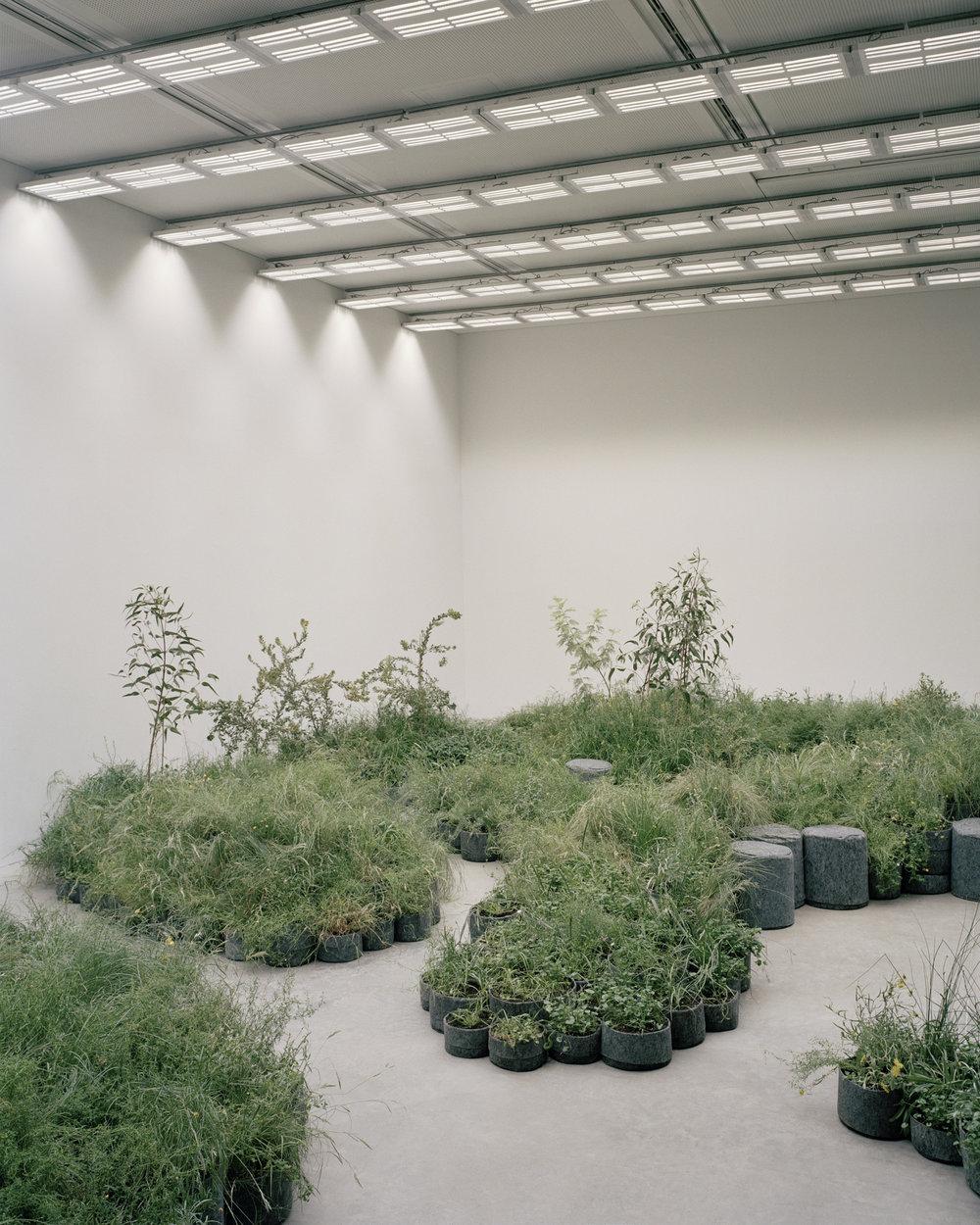
Baracco+Wright and Linda Tegg, Repair The Australian Pavilion Biennale Architettura 2018, Venice. Photo: Rory Gardiner
What do you think this act of restoration that you guys are taking on does in terms of the future of these plant communities and in relation to the land? Taking it from Australian land to Italy and nursing them…the title of the project is “repair” – what does that imply in relation to what you are trying to do here?
It’s difficult to know what it does but I think that there’s a real genuine act in caring, and making that care visible to a wider population – it’s something that isn’t often seen. There’s also something that occurs when you move something like a Grassland plant community that has for the past hundred years been devalued into the Australian Pavilion in the Venice Biennale and allowing it to literary represent itself in a space that is held for objects of cultural significance.
It’s interesting to think of these natural forms as cultural artifacts.
We are asking them to represent themselves. There’s a dynamic within the work that’s both romantic and literal. That is always at play based on how we’ve come to understand something like a prairie or a rolling green hill as a coded symbolic form. What’s very important is the literal plants in the space. We adapt the building to their needs, we put the plants at the centre.
How is this different from when you did this a few years ago when it wasn’t in the context of a pavilion?
It’s different in a few ways. The first one was site-specific in a more direct way. For the biennale, there were all sorts of acts of displacement going on and obviously we have been shipping seeds from Australia into Italy and that could be seen as an act of colonization in and of itself. We have then brought it into a gallery and a building that is not designed to host or allow for plant life. It makes for an interesting dynamic to have plant life for a building that is hermetically sealed and provides little to no access to sunlight. In response to those conditions, the work changes considerably.
You mention the work being literal. In terms of how we think about nature through photography, how is that literal view broken up with photography? We often think about photography as being this literal parallel to what we see. If one is not surrounded by nature, that becomes the way we understand it.
For me, photographs are always constructed. I don’t subscribe to the idea that it is a true parallel. In some of my early works, I started to investigate this through photographing animals that had been trained to embody our idea of animal behaviour but for the camera. There’s always this understanding of a performance and untrustworthiness in the image. I’m really interested in what happens when things don’t play out based on the expectations we have set out for nature from what we’ve learned watching nature documentaries. I look to images to see how those notions are constructed and see if I can find a way of understanding things and seeing things differently.
In terms of seeing things in a new way, do you think that happens through these installations of grass?
With one of my previous works, One World Rice Pilaf, I grew what I could from the supermarket -unknowing these commodities as food and knowing them as plants to find that connection and rethinking.
I think because grains are not sold as plants, to a lot of people the plants themselves are quite foreign. It was so difficult to recognize that I needed to install a species list adjacent to the plants so people knew what they were looking at.
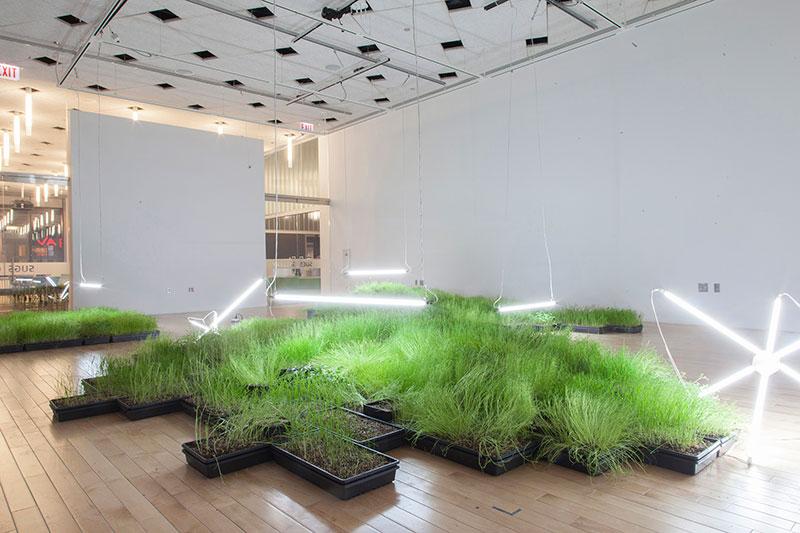
One World Rice Pilaf, 2016 from the exhibition Mercury a collaboration with Brian M John and Linda Tegg
What goes into picking and choosing the seeds?
With that work, I worked through the whole bulk section. I was interested in seeing what grew into what. I also became interested in the meatpacking industry. I wanted to get a sense of these animals as they were. I found it difficult to bring a pig from the meatpacking industry into Chicago when I was there. Even though I was pushing for it, it was very hard to make these animals visible. You think about the millions of animals that pass through a place like Chicago – that are never seen – it’s pretty interesting. That is furthered by Ag-gag [LT1] Laws that make it illegal for people to make images in slaughterhouses and such. And so there appears to be an active obfuscation between the animals we eat and us. I find that quite remarkable.
I also thought about this strange phenomenon: the petting zoo. It is something that I have always had a bit of anxiety about. There’s something that seems a little bit strange about it. There’s really a desire to touch and to hold that petting zoos fulfill. Through this strange arrangement of baby animals, there may be one way of drawing that connection. So I decided to invite a petting zoo into the gallery and for the animals to just wonder around, to be in that space. This idea of holding, carrying, and having connection with animals we often think of as a food source. I had the animal handler come pick the animals one after the other for a camera close up. In post-production, the handlers became almost invisible. The human was either disappearing or made visible by their contact with the animal.
.png)
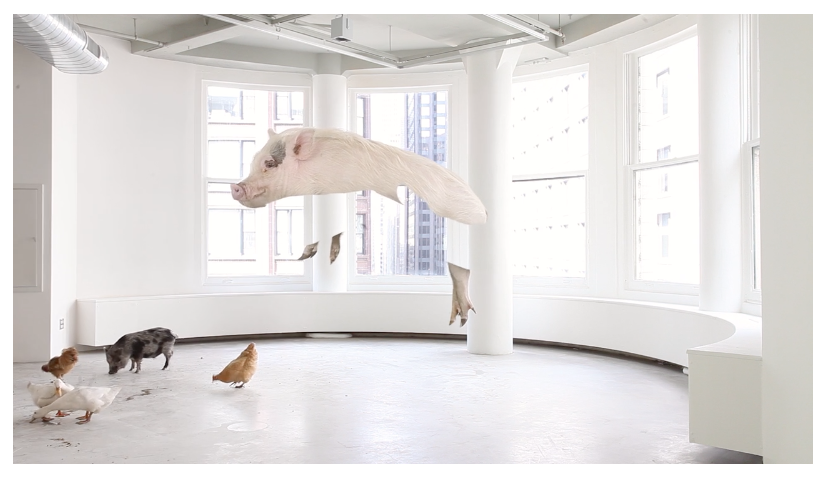
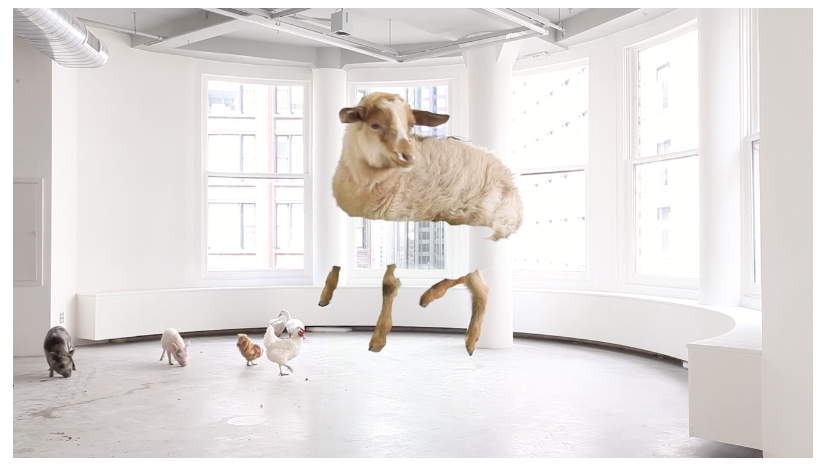
stills from Contact, 2016 at Chicago’s Sullivan Galleries.
I’m curious, how do you go to a petting zoo and convince them that you’d like them in a gallery for art? What do you say?
They are quite open. They’re established businesses that bring their animals to different events and campuses, so I didn’t think I was asking them to do anything too far out of the ordinary. For them, they believe in what they are doing with the petting zoo and educating children about animals. But they did have to trust me with the representation of their animals. It turned out well in the end.
The handlers have very strong relationships with the animals and shared many stories about how they were rescued and live alongside each other. They all talked about the animals like they were their pets. That was interesting and something I didn’t expect.
The Sullivan Galleries, where we filmed them, is not accustomed to having live animals inside so there was a long process of risk management and insuring that no one would accidentally come in contact with an animal they didn’t expect that day. Occasionally, it felt a bit absurd. It reinforced to me how animals are in the building every day in the form of lunch and that’s not a problem, but one live animal brings phone calls to the legal department and forms of compliance. It highlighted to me how difficult it is to have any connection in these spaces that aren’t sanctioned for animal life.
It's interesting you are calling the animals, ‘animals’ even though they are food.
I’m talking very general terms. I think it’s the work I did with One World Rice Pilaf that made me jump from something very benign like rice as food source to thinking of it as a living plant. To me, it points to a shift in categories that I find interesting.
Was it illuminating in any way speaking with those handlers about their relationship with the animals? Especially since you had anxieties about petting zoos.
I think before you get to know about the practices from the outside, it’s easy to think of it in simplistic terms. I first approached it thinking about this desire to touch and hold these animals that we consider food sources. As an outsider, you often wonder how these animals came to be in the petting zoo and if they are ok. The animals in the video were adopted and they live alongside the owners of the petting zoo in their house, so there’s a whole world connection that happens outside the public performance.
There’s a slight humour that comes out of a lot of your work. I think as a result of the way you present these animals and plants.
I think often I work in a fairly open way and things play out all kinds of ways. Sometimes there’s real uncomfortable absurdity that comes out of the work.
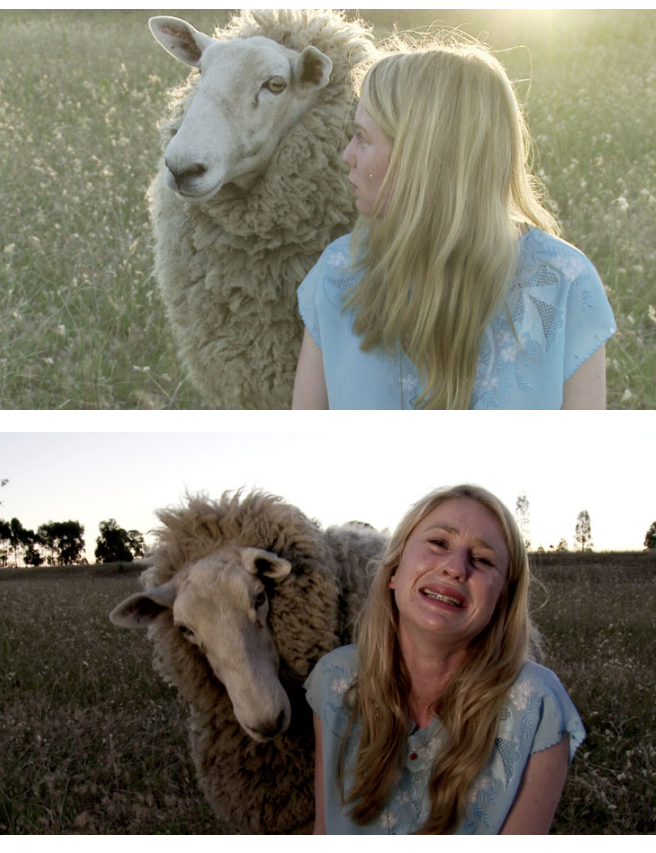
You’ve been interested in challenging objectivity and how people look especially through photography. In thinking about photography as a surface for truth-making, and putting your ideas in that same space, how do you highlight ideas of fiction within things that suppose to be objective?
One thing I tend to do is bring representation in close proximity to the thing itself. That might be bringing an image into the same space as a live performance. Some of the earlier works I made were really concerned about the dynamic between the comfort and passivity of looking at an image and looking at a live person that can look right back at you. I always push for a dynamic between the viewer and the artwork.
Before we finish, I want to go back and maybe trace when you started to get into photography and how you progressed into thinking through the medium and relating it to nature. What are some of your earliest engagements with photography as such?
I started out in commercial photography. In this sphere, I became very interested in the bodies that were used by advertisers to sell. For one of my first beauty editorials, I created a catalogue of photographs of male models at specified heart rates 60-190 beats per minute. It was an effective editorial as the models beautifully sweated out their hairstyles, but it was also a way of registering and engaging with the physical bodies that make advertising images possible. I think this signaled the future direction of my work.